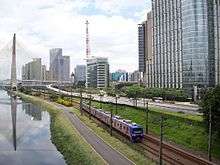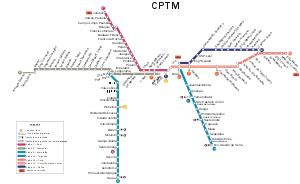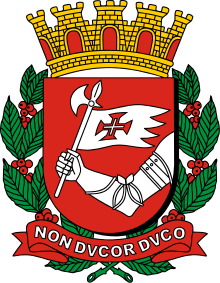Companhia Paulista de Trens Metropolitanos
.svg.png) | |||
 | |||
| Overview | |||
|---|---|---|---|
| Owner | São Paulo (state) Government | ||
| Locale | Greater São Paulo | ||
| Transit type | Commuter rail | ||
| Number of lines | 6 | ||
| Number of stations | 92 | ||
| Daily ridership | 2,900,000 (2014) | ||
| Annual ridership | 795,000,000 (2013) | ||
| Chief executive | Mário Manuel Seabra Rodrigues Bandeira | ||
| Headquarters | Rua Boa Vista, 185, Centro | ||
| Website |
www | ||
| Operation | |||
| Began operation | May 28, 1992 | ||
| Operator(s) | CPTM | ||
| Number of vehicles | 126 (2010) | ||
| Technical | |||
| System length | 258.4 kilometres (160.6 mi) | ||
| Track gauge | 1,600 mm (5 ft 3 in) | ||
| Electrification | 3,000V DC catenary | ||
| Average speed | 60 km/h (37 mph) | ||
| Top speed | 100 km/h (62 mph) | ||
| |||
Companhia Paulista de Trens Metropolitanos (CPTM) (English: São Paulo Metropolitan Train Company) is a commuter rail company owned by the São Paulo State Secretariat for Metropolitan Transports. It was created in 1992 from several railroads that already existed in Greater São Paulo, Brazil.
Part of the Greater São Paulo rail network, CPTM has 92 stations in six lines, with a total length of 258.4 kilometres (160.6 mi). It is one of the busiest rail networks in the world, carrying over 2 million passengers a day.
History
The railways now run by CPTM were built between 1860 and 1957 by the São Paulo Railway (lines 7 and 10), Estrada de Ferro Sorocabana (lines 8 and 9), Companhia São Paulo e Rio de Janeiro (line 11) and Estrada de Ferro Central do Brasil (line 12).
These railways were eventually incorporated into the state-owned Rede Ferroviária Federal (RFFSA) in 1957 and Ferrovia Paulista S.A. (FEPASA) 1971. Finally, in 1992 the urban sections of RFFSA and FEPASA merged, forming CPTM.
Operation
CPTM operates six lines in the Greater São Paulo area, identified by number and color. Most of these lines run on surface tracks and share right of way with freight trains.
Service starts every day at 4 AM, when trains depart from each terminus, until the last train leaves at midnight. On Saturdays operation is extended until 1 AM.
The company charges a flat fare that can be paid either by magnetic ticket sold in the stations or with a rechargeable smartcard, and grants access to any of the rail lines on the Greater São Paulo.
Lines
| Line | Color | Terminus | Length | Stations | Daily Ridership |
|---|---|---|---|---|---|
| Line 7 | Ruby | Luz ↔ Jundiaí | 60.5 kilometres (37.6 mi) | 18 | 386.000 |
| Line 8 | Diamond | Júlio Prestes ↔ Amador Bueno | 41.7 kilometres (25.9 mi) | 22 | 414.000 |
| Line 9 | Emerald | Osasco ↔ Grajaú | 31.8 kilometres (19.8 mi) | 18 | 266.000 |
| Line 10 | Turquoise | Brás ↔ Rio Grande da Serra | 34.9 kilometres (21.7 mi) | 13 | 330.000 |
| Line 11 | Coral | Luz ↔ Estudantes | 50.8 kilometres (31.6 mi) | 16 | 526.000 |
| Line 12 | Sapphire | Brás ↔ Calmon Viana | 38.8 kilometres (24.1 mi) | 13 | 199.000 |
Expansion
| Line | Color | Terminals | Length | Stations | Status |
|---|---|---|---|---|---|
| Line 9 | Emerald | Grajaú ↔ Varginha | 4.36 kilometres (2.71 mi) | 3 | under construction |
| Line 13 | Jade[1] | Engenheiro Goulart ↔ Guarulhos International Airport | 11 kilometres (6.8 mi) | 3 | under construction |
| Line 10 - Expresso ABC | Turquoise | Luz ↔ Mauá | 25.2 kilometres (15.7 mi) | 6 | in study |
Gallery
 Internal view of CPTM train
Internal view of CPTM train- Socorro station
 CPTM train in Brooklin CBD
CPTM train in Brooklin CBD- A new series 7000 train at Eng. Goulart station
See also
- São Paulo Metro
- List of suburban and commuter rail systems
- Transport in São Paulo
- Bike station - The Mauá train station on Line 10 has a bike station, the only one on the CPTM system.
References
External links
| Wikimedia Commons has media related to Companhia Paulista de Trens Metropolitanos. |
- (Portuguese) Official page of the CPTM
- (Portuguese) Secretaria dos Transportes Metropolitanos

